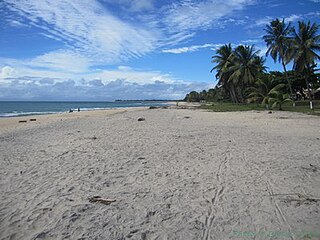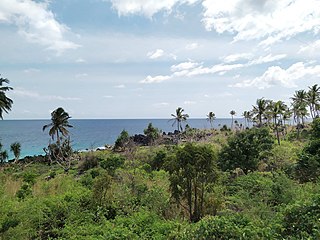The Global 200 is the list of ecoregions identified by the World Wide Fund for Nature (WWF), the global conservation organization, as priorities for conservation. According to WWF, an ecoregion is defined as a "relatively large unit of land or water containing a characteristic set of natural communities that share a large majority of their species dynamics, and environmental conditions". For example, based on their levels of endemism, Madagascar gets multiple listings, ancient Lake Baikal gets one, and the North American Great Lakes get none.

The Madagascar lowland forests or Madagascar humid forests are a tropical moist broadleaf forest ecoregion found on the eastern coast of the island of Madagascar, home to a plant and animal mix that is 80 to 90% endemic, with the forests of the eastern plain being a particularly important location of this endemism. They are included in the Global 200 list of outstanding ecoregions.

The Madagascar subhumid forests are a tropical moist broadleaf forest ecoregion that covers most of the Central Highlands of the island of Madagascar. They are included in the WWF's Global 200 list of outstanding ecoregions. Most of the original habitats have been lost due to human pressure.

The environment of Sri Lanka is unique in being one of the world's bio-diversity hot-spots.

The Madagascar dry deciduous forests represent a tropical dry forest ecoregion situated in the western and northern part of Madagascar. The area has high numbers of endemic plant and animal species but has suffered large-scale clearance for agriculture. They are among the world's richest and most distinctive dry forests and included in the Global 200 ecoregions by the World Wide Fund. The area is also home to distinctive limestone karst formations known as tsingy, including the World Heritage Site of Bemaraha.

Sava is a region in northern Madagascar. Its capital is Sambava. Until 2009 Sava belonged to Antsiranana Province. The region is situated at the northern part of the east coast of Madagascar. It is bordered by the region Diana to the north, Sofia to the west, and Analanjirofo to the south. As of 2018, its population was 1,123,013 and the total area is 25,518 km2 (9,853 sq mi). The region contains wild areas such as Marojejy National Park.

The Anjajavy's Protected Area is located on a peninsula of the town of Antonibe, in the district of Analalava and in the north-west region of Madagascar. It is part of the Sofia region of the independent province of Mahajanga and its position is between 47°13’ at 44°22’ of longitude east and 14°58 at 15°07’ of latitude south..

The golden-crowned sifaka or Tattersall's sifaka is a medium-sized lemur characterized by mostly white fur, prominent furry ears, and a golden-orange crown. It is one of the smallest sifakas, weighing around 3.5 kg (7.7 lb) and measuring approximately 90 cm (35 in) from head to tail. Like all sifakas, it is a vertical clinger and leaper, and its diet includes mostly seeds and leaves. The golden-crowned sifaka is named after its discoverer, Ian Tattersall, who first spotted the species in 1974. However, it was not formally described until 1988, after a research team led by Elwyn L. Simons observed and captured some specimens for captive breeding. The golden-crowned sifaka most closely resembles the western forest sifakas of the P. verreauxi group, yet its karyotype suggests a closer relationship with the P. diadema group of eastern forest sifakas. Despite the similarities with both groups, more recent studies of its karyotype support its classification as a distinct species.

The northern rufous mouse lemur, northern brown mouse lemur, or Tavaratra mouse lemur is found in northern Madagascar from the Ankarana Special Reserve in the west to the Manambato River in the northeast, and up to the Irodo River in the north of the Analamerana Special Reserve. The complete distribution range of M. tavaratra is still to be defined as some areas surrounding the described distribution have not been visited yet. For example, M. tavaratra has been reported to possibly occur from the Irodo up to the Montagne des Français. Its known distribution cover four protected areas – the Ankarana Special Reserve, and the Analamerana Special Reserve both managed by Madagascar National Parks, the Loky-Manambato protected area (Daraina), and the Andavakoeira-Andrafiamena protected area, both Managed by the NGO Fanamby

Menabe Antimena is a protected area in Menabe region of western Madagascar. It belongs to the municipalities of Tsimafana, Beroboka, Bemanonga, Belon'i Tsiribihina, and Tsaraotana.

Daraina is a town and commune in northern Madagascar. It belongs to the district of Vohemar, which is a part of Sava Region. The city is located at the unpaved part of the Route Nationale 5a between Vohemar and Ambilobe.

The Kirindy Mitea National Park is a national park on the coast of the Mozambique Channel, in south-west Madagascar. The 72,200 hectares park contains many endemic animals and plants and claims to have the greatest density of primates in the world.
Analamerana Special Reserve is a 347 square kilometres (134 sq mi) wildlife reserve in the north of Madagascar. The reserve was created in 1956 to protect its endemic plants and animals, such as the critically endangered Perrier's sifaka, which is considered to be one of the most endangered primates in the world.
Ambatovaky Special Reserve is a tropical rainforest and wildlife reserve in the north-east of Madagascar. It is designated by Bird Life International as an Important Bird Area for the large number of endemic species of birds.
Maningoza Special Reserve is a 9,826 hectares wildlife reserve in Madagascar. It was created in 1956 to protect the many endemic plants and animals, and it also contains some of the last remaining areas of dry deciduous forest on the island.

The Daraina sportive lemur is a sportive lemur endemic to Madagascar. It is a relatively small sportive lemur with a total length of about 49 to 56 cm, of which 24–27 cm (9.4–10.6 in) are tail.

The Comoros forests is a terrestrial ecoregion which covers the Comoro Islands, which lie in the Mozambique Channel between Madagascar and East Africa. These include four main islands: Grande Comore, Anjouan and Mohéli, of the Union of the Comoros, and Mayotte, a department and region of France.
The Ankarana Special Reserve tufted-tailed rat is a species of rodent in the family Nesomyidae. It was first described in 2009. It is endemic to Madagascar, in the Ankarana Special Reserve.
Eremolaena darainensis is a tree in the family Sarcolaenaceae. It is endemic to Madagascar. It is named for its native commune of Daraina.
Analavelona, also known as Analavelona Massif, is a mountain in southwestern Madagascar. The massif is home to an enclave of montane subhumid forest, which is considered a sacred forest by the local people and notable for its biodiversity.














